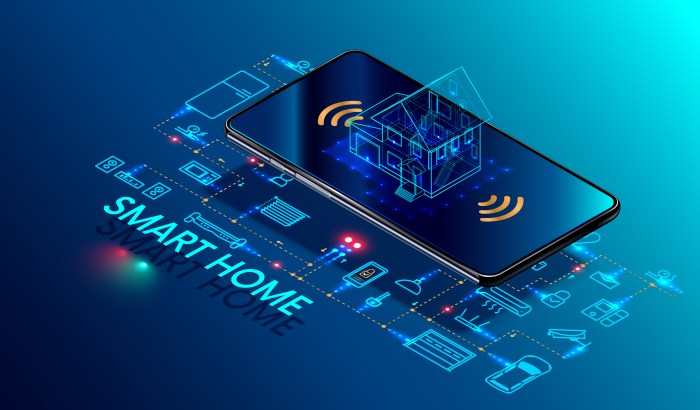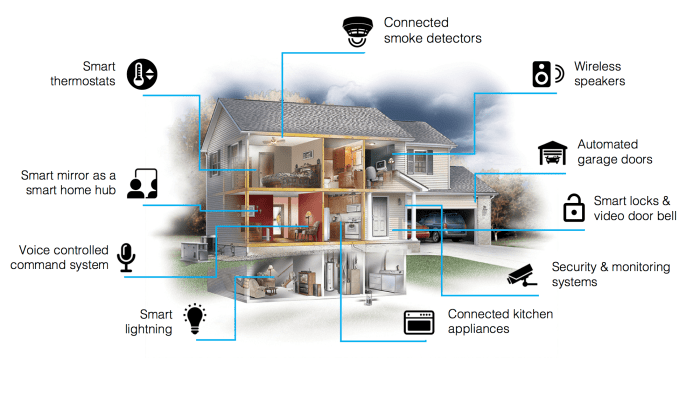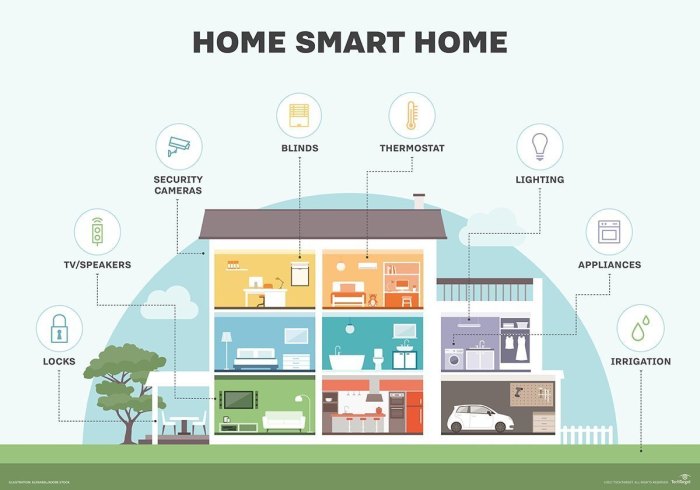Smart home system with wireless connectivity – Smart home systems with wireless connectivity are transforming the way we live, offering unprecedented convenience, efficiency, and security. Dive into this comprehensive guide to discover the transformative power of these systems and how they can elevate your home experience.
From the seamless integration of smart devices to the robust security features that safeguard your privacy, this guide unravels the intricacies of smart home systems, empowering you to make informed decisions and embrace the future of home automation.
Smart Home System Overview

A smart home system refers to a network of interconnected devices within a home that can be controlled and monitored remotely using a smartphone, tablet, or computer. These devices work together to automate tasks, enhance convenience, and provide increased security and energy efficiency.
By integrating various devices, such as lighting, thermostats, door locks, and appliances, a smart home system offers numerous benefits. These include:
Enhanced Convenience
- Remote control of devices from anywhere with an internet connection.
- Automated tasks, such as turning on lights at sunset or adjusting the thermostat based on temperature.
- Voice control through smart speakers or assistants, allowing hands-free operation.
Increased Security
- Smart door locks with remote access and activity monitoring.
- Motion sensors and security cameras for real-time alerts and deterrence.
- Automated notifications in case of suspicious activity or emergencies.
Improved Energy Efficiency
- Smart thermostats that adjust temperature based on usage patterns and preferences.
- Energy monitoring devices that track consumption and identify areas for optimization.
- Automated lighting control to reduce energy waste.
Wireless Connectivity
Smart home systems rely heavily on wireless connectivity to enable communication between various devices and the central hub. This section explores the different wireless technologies commonly employed in smart home systems, highlighting their advantages and disadvantages.
Wi-Fi
Wi-Fi is a popular wireless technology that provides high-speed internet access and data transfer within a home network. It operates on the 2.4 GHz and 5 GHz frequency bands, offering a wide range of coverage and speeds.
- Advantages:Extensive coverage, high bandwidth, supports multiple devices simultaneously.
- Disadvantages:Can be susceptible to interference from other devices, higher power consumption.
Bluetooth
Bluetooth is a short-range wireless technology primarily used for connecting devices over short distances, such as pairing smartphones with speakers or headphones. It operates on the 2.4 GHz frequency band.
- Advantages:Low power consumption, easy pairing, suitable for low-bandwidth applications.
- Disadvantages:Limited range, not suitable for high-bandwidth applications.
Zigbee
Zigbee is a low-power wireless technology designed specifically for smart home applications. It operates on the 2.4 GHz frequency band and employs a mesh network topology, allowing devices to communicate with each other and extend the network’s range.
- Advantages:Low power consumption, mesh network topology, high reliability.
- Disadvantages:Lower bandwidth compared to Wi-Fi, limited device compatibility.
Components of a Smart Home System
A smart home system is a network of interconnected devices that can be controlled remotely or automatically. These devices can include everything from lights and thermostats to security cameras and door locks.
The key components of a smart home system are:
- Hub:The hub is the central control unit for the smart home system. It connects to all of the other devices in the system and allows them to communicate with each other.
- Sensors:Sensors collect data about the environment and send it to the hub. This data can be used to trigger actions, such as turning on the lights when someone enters a room or adjusting the thermostat when the temperature changes.
- Actuators:Actuators are devices that perform actions based on the data collected by the sensors. For example, an actuator could turn on a light, adjust a thermostat, or lock a door.
Smart Home Devices
Smart home devices are the building blocks of a smart home system. They provide the functionality and convenience that make smart homes so appealing. There are a wide variety of smart home devices available, each with its own unique set of features and capabilities.
Some of the most common types of smart home devices include:
- Smart lighting: Smart lighting systems allow you to control your lights from anywhere, using a smartphone app or voice commands. This can be convenient for a variety of reasons, such as turning on the lights when you get home from work or turning them off when you go to bed.
- Smart thermostats: Smart thermostats allow you to control your home’s temperature from anywhere, using a smartphone app or voice commands. This can help you save money on energy bills by automatically adjusting the temperature when you’re away from home.
- Smart security systems: Smart security systems can help you keep your home safe and secure. They can include features such as motion sensors, door and window sensors, and security cameras. You can receive alerts on your smartphone if any of these sensors are triggered, and you can even view live footage from the security cameras.
These are just a few examples of the many different types of smart home devices available. By integrating these devices into your home, you can enjoy a more convenient, efficient, and secure living experience.
Smart Home Protocols

Smart home protocols define the communication standards and languages used by smart home devices to connect and interact with each other. These protocols enable seamless data exchange, device control, and interoperability within a smart home system.There are various smart home protocols available, each with its own strengths and areas of focus.
Some of the most widely used protocols include:
Z-Wave
- A wireless mesh network protocol specifically designed for smart home applications.
- Provides reliable and low-power communication between devices.
- Widely supported by a range of smart home devices, including lights, switches, sensors, and more.
Matter
- A relatively new protocol developed by the Connectivity Standards Alliance (CSA).
- Aims to unify the smart home industry by providing a common communication standard for devices from different manufacturers.
- Designed to be secure, interoperable, and compatible with existing smart home protocols.
Compatibility and Interoperability
The compatibility and interoperability of smart home protocols are crucial for creating a seamless and cohesive smart home experience. To ensure interoperability, devices should be certified to support the same protocol.Some protocols, such as Matter, are designed to be interoperable with other protocols, allowing devices from different manufacturers to communicate and work together.
Wireless connectivity in smart home systems is reshaping home automation, enabling seamless control of devices. For those curious about the financial implications, we recommend reading Unveiling the Cost Enigma: Exploring Smart Home System Prices in India to gain insights into the cost structure of smart home systems.
Understanding the price range empowers homeowners to make informed decisions while embracing the convenience of wirelessly connected smart homes.
This cross-protocol compatibility enhances the flexibility and scalability of smart home systems.
Smart Home Security

Smart home systems enhance security by providing advanced features that protect against unauthorized access and data breaches.
Smart home systems employ a range of security measures to safeguard user privacy and property, including:
Motion Sensors
- Detect movement within a designated area, triggering alerts and activating security measures.
- Provide early warning of potential intrusions or suspicious activity.
Door and Window Sensors
- Monitor the opening and closing of doors and windows, alerting users to any unauthorized access.
- Help prevent break-ins and protect valuable belongings.
Smart Locks
- Allow remote locking and unlocking of doors using a smartphone or other device.
- Provide additional security against unauthorized entry, even if keys are lost or stolen.
Security Cameras
- Provide real-time monitoring of the home’s interior and exterior.
- Capture footage of potential intruders or suspicious activity, aiding in investigations.
Data Encryption
- Encrypts data transmitted between smart home devices and the central hub.
- Protects sensitive information, such as passwords and security settings, from unauthorized access.
Remote Monitoring
- Allows users to monitor their home remotely via a smartphone or web interface.
- Provides peace of mind and enables quick response to security alerts.
Smart Home Privacy: Smart Home System With Wireless Connectivity
Smart home systems have raised concerns about privacy as they collect and transmit data related to user activities and preferences. These concerns stem from the potential for unauthorized access to data, misuse of information, and surveillance.
Smart home systems with wireless connectivity offer convenience and automation. However, if you’re looking for cost-effective and sustainable alternatives, consider exploring the guide in Exploring Smart Home Alternatives . This comprehensive resource provides DIY solutions and eco-friendly options to enhance your smart home experience while maintaining wireless connectivity.
To address these concerns, various measures have been implemented to protect user data and privacy. These measures include:
Encryption and Data Security
- Data encryption: Communication between smart home devices and cloud servers is encrypted to prevent unauthorized access to sensitive information.
- Secure storage: User data is stored in secure databases with restricted access and robust security protocols.
User Control and Transparency
- Privacy settings: Users can customize privacy settings to control the collection and sharing of data.
- Transparency: Companies provide clear privacy policies and terms of service that explain how user data is collected, used, and shared.
Independent Certifications and Standards
- Certifications: Smart home systems can obtain independent certifications, such as UL 2900-2-2, which demonstrate compliance with industry privacy standards.
- Privacy-by-design: Systems are designed with privacy in mind, minimizing data collection and ensuring secure data handling practices.
Ethical Considerations, Smart home system with wireless connectivity
- Data minimization: Companies are encouraged to collect only the data necessary for the proper functioning of smart home systems.
- Respect for privacy: Manufacturers and service providers are expected to respect user privacy and avoid using data for purposes beyond those agreed upon.
Smart Home Integration

Smart home systems can be integrated with other home systems, such as entertainment systems and HVAC systems, to create a more seamless and convenient living experience.
For example, a smart home system can be integrated with an entertainment system to allow users to control their TV, music, and other devices using voice commands or a mobile app. This can make it easier to find and play content, adjust the volume, and even turn off the TV when you’re finished watching.
Smart home systems can also be integrated with HVAC systems to allow users to control the temperature, humidity, and air quality in their homes. This can help to improve comfort and energy efficiency.
Benefits of Smart Home Integration
There are many benefits to integrating smart home systems with other home systems, including:
- Convenience: Smart home integration can make it easier to control all of your home’s systems from a single interface.
- Comfort: Smart home integration can help to improve comfort by allowing you to control the temperature, humidity, and air quality in your home.
- Energy efficiency: Smart home integration can help to improve energy efficiency by allowing you to control your home’s systems more efficiently.
- Security: Smart home integration can help to improve security by allowing you to monitor your home’s systems and receive alerts if there is a problem.
Smart Home Trends
The smart home industry is constantly evolving, with new trends emerging all the time. These trends are shaping the future of smart home systems, making them more convenient, efficient, and secure.
One of the most important trends in smart home technology is the increasing use of artificial intelligence (AI). AI-powered smart home devices can learn your habits and preferences, and they can automate tasks to make your life easier. For example, an AI-powered smart thermostat can learn your heating and cooling preferences and adjust the temperature accordingly.
An AI-powered smart speaker can learn your music preferences and play your favorite songs when you come home from work.
Another important trend in smart home technology is the increasing use of voice control. Voice control allows you to control your smart home devices with your voice, making it easier and more convenient to use them. For example, you can use your voice to turn on the lights, adjust the thermostat, or play music.
Smart Home Security
Smart home security systems are becoming increasingly popular as homeowners look for ways to protect their homes and families. Smart home security systems can include a variety of devices, such as security cameras, motion sensors, and door and window sensors.
These devices can be monitored remotely using a smartphone app, so you can always keep an eye on your home, even when you’re away.
Smart Home Privacy
As smart home technology becomes more popular, concerns about privacy are also growing. Smart home devices collect a lot of data about your habits and preferences, and this data can be used to track your movements or even identify you.
It’s important to be aware of the privacy risks associated with smart home technology and to take steps to protect your privacy.
Last Recap

As the smart home landscape continues to evolve, the possibilities are endless. Embrace the transformative power of smart home systems with wireless connectivity and unlock a world of convenience, efficiency, and peace of mind. The future of home automation is here, and it’s ready to revolutionize your living experience.